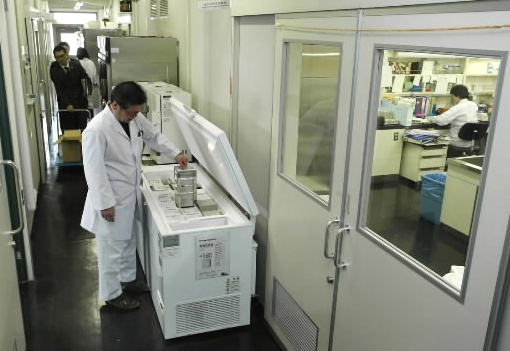Special Series: 60 Years of RERF, Part I [4]
Jun. 30, 2010
Moving beyond its past: Stalled relocation
by Masayoshi Ishikawa, Staff Writer
This feature series on the past and future of the Radiation Effects Research Foundation (RERF) originally began to appear in the Chugoku Shimbun in February 2007.
Intentions of Japan and the U.S. at cross-purposes
A staff member in a white coat is caught in a cramped pose, working with a large piece of equipment placed in a narrow hallway in the Radiation Effects Research Foundation in Minami Ward, Hiroshima. The building evokes the feeling of an army barracks; coexisting at the institute is state-of-the-art equipment with the aging past.
The Atomic Bomb Casualty Commission (ABCC), the forerunner of RERF, was completed at the current site at the top of Hijiyama Hill in 1950. The U.S. military took charge of the design and construction of the institute. "Though we have been repairing the facility within our budget, we cannot keep pace with the need," said Hiroyuki Yamane, chief of the Supply and Property section. Cracks in the wall caused by the Geiyo Earthquake of 2001 remain unrepaired.
When Typhoon No. 18 struck in September 2004, it caused a blackout for more than twelve hours. With reserve fuel running low and the in-house generator on the verge of quitting, RERF employees resorted to driving trucks to local gas stations in order to prevent the loss of blood samples from A-bomb survivors (hibakusha) that were being preserved at low temperature.
Plans to relocate the institute have been discussed for some time to address the problem of the aging facilities. In 1986, the City of Hiroshima acquired an area of 7,000 square meters at the former site of Hiroshima University's Faculty of Engineering, in downtown Hiroshima, and made preparations for the move. The City Assembly has also approved the written call for the relocation on three separate occasions.
Still, the plan has foundered. RERF has run up against a wall of "diplomacy." RERF's budget is borne by both the Japanese and the U.S. governments. In the past, RERF has been unilaterally notified several times by the American side of a cut or freeze in the budget on the grounds of a U.S. political timetable or White House policy. The budget for the last fiscal year was 3.66 billion yen, a cut of more than 1 billion yen over ten years.
In 1993, RERF prepared a blueprint of its relocation. It planned to complete a new five-story building with a basement in the spring of 1996. But the Clinton administration, eager to reduce the budget deficit, rejected the idea.
The former mayor of Hiroshima, Takashi Hiraoka, visited the U.S. Department of Energy (DOE) to pursue negotiations for RERF's relocation, but these talks proved disappointing. "They won't let go of the data they hold," Mr. Hiraoka said. "What's more, they assumed an attitude of wanting to invest as little as possible in RERF." It would appear that the two sides were talking at cross-purposes, as the DOE, with RERF's budget in its hands, is also charged with the development of nuclear weapons.
"I was going to tell them that Japan could take over the running of RERF without the United States, but the Ministry of Foreign Affairs stopped me," he continued. "The Ministry was hesitant toward the United States, which claims ownership of the research results." He also expressed doubts about the Japanese government in the matter.
Though RERF compiled a tentative plan for the future in 2005, it focused solely on introducing its research themes. The plan was roundly criticized by RERF's Scientific Council, a panel of experts, which expressed concern that no operational strategy was presented. It went on to say that the budget crisis showed a lack of communication between the Japanese and U.S. governments.
In December 2006, the Joint Senior Review Group was established to weigh the future of RERF. A third-party panel consisting of four members each from Japan and the United States, its mandate involves discussing future research policy and the personnel system at RERF. However, the DOE has been reticent in its attitude toward future operations, noting that it would be difficult to deal with anything other than scientific challenges.
Though the City of Hiroshima and the medical association have long been calling for relocation, to date nothing has changed. Mr. Hiraoka, in explaining the difficulty, said, "The DOE is only interested in the results of the research while the Japanese government follows the U.S. lead. The relocation issue shows that neither the Japanese nor the U.S. governments take the future of RERF seriously."
(Originally published on March 2, 2007)








